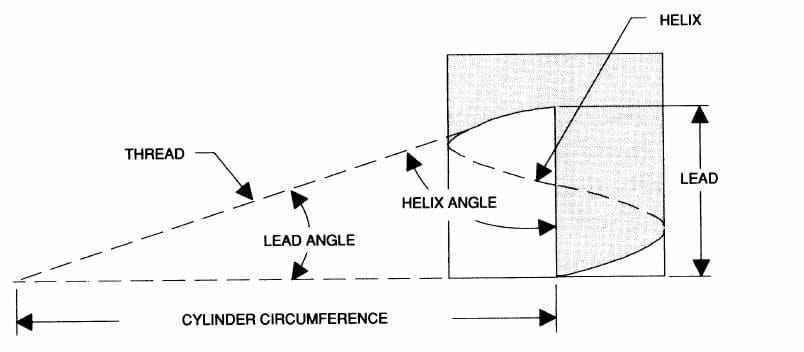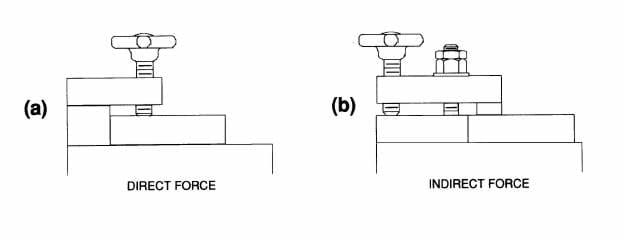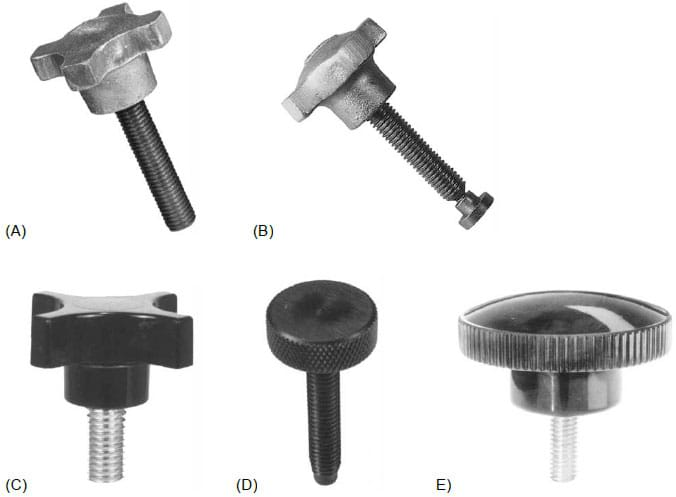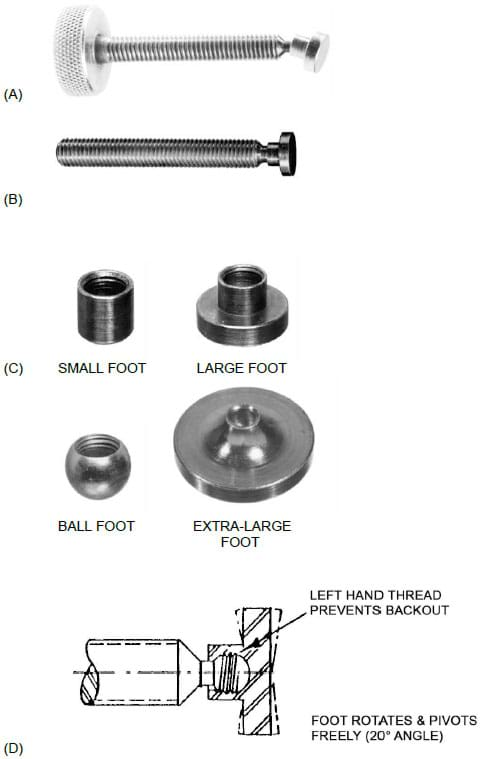Screw clamps are among the simplest and least-expensive clamps in use today. Screw clamps offer the designer more clamping options than many other types of clamps.
For clamping effectiveness and size/force ration, screw clamps make excellent workholders. But they also have a drawback. Their inherently slow clamping speed limits their use in high production jigs and fixtures.
Screw clamps are commonly used in woodworking and metalworking. But they can also be used in many other applications where objects need to be held securely in place. They are known for their versatility, ease of use, and relatively low cost. Some screw clamps have adjustable jaws that can be moved to accommodate different sizes of objects, making them useful for clamping a wide range of materials.
How Do Screw Clamps Work?
The principle behind the screw thread is the inclined plane. When applied to a cylinder, the inclined plane converts to a helix. If a thread were unwrapped from a screw, the resulting shape of the thread relative to the screw should be triangular.
As shown in Figure 8-44, each part of the triangle has a physical relationship to the screw. The hypotenuse represents the length of the thread around the screw. The side adjacent shows the circumference of the screw, and the side opposite represents the lateral movement of the thread along the screw.
 Figure 8-44. A screw thread is an inclined plane. Its features can be explained as they relate to a triangle.
Figure 8-44. A screw thread is an inclined plane. Its features can be explained as they relate to a triangle.
The helical form of the thread is created by wrapping the triangle around a cylindrical form. This allows the thread to transmit lateral movement along the axis of the screw. The specific amount of lateral movement per revolution is called the “lead” of the thread.
A term often confused with the lead is the “pitch.” The pitch of a thread is the distance from a point on one thread to the same point on the next adjacent thread. With single-lead threads, the lead and pitch are the same, but with multiple-lead threads, they are different.
The shorter the lead the better the holding action so fine pitches are sometimes selected when vibration might loosen the thread. But with shorter leads, the screw must make more revolutions to cover the necessary line distance. So, although the screw thread is an excellent clamping device, the additional time needed to tighten a screw can be objectionable in some situations.
The best and least-expensive solution to the loosening problem is to select standard-size threads and position the screw to minimize the effects of vibration. This can be done with indirect clamping force.
As shown in Figure 8-45(a), positioning a screw directly on a workpiece increases the chances that vibration will turn the screw. But if the screw applies force to the workpiece indirectly, Figure 8-45(b), the vibration is absorbed by the clamp strap before it affects the screw.
 Figure 8-45. Direct and indirect clamping with a screw clamp.
Figure 8-45. Direct and indirect clamping with a screw clamp.
Standard clamping screws are designed for either direct- or indirect-pressure clamping. The most common clamp screws have a hand knob, knurled head, or socket head attached to a threaded stud. Many variations of clamp screws are available for varied needs.
Types of Screw Clamps
Bar Handle Screw Clamps
Heavy-duty screw clamp with a sliding bar handle for excellent leverage. The bar can be moved to any position for convenient tightening and is held in place by light spring force. These screw clamps accept all standard types of swivel feet. They are available in steel or stainless steel.
[View Our Selection of Bar Handle Screw Clamps]
Hand-Knob Screw Clamps
Hand knobs with screws are a common form of hand screw clamp. The most common are shown in Figure 8-46. The hand-knob assembly (a) and the knob-shoe assembly (b) are similar in design.
Both are found in either direct or indirect clamping operations, but the handle-knob assembly is usually selected for indirect applications. Here, the dog-point end is often aligned in a slot.
The knob-shoe assembly has a swivel pad at the end of the screw, useful in direct-pressure applications. Here, the swivel pad contacts the workpiece and remains stationary while the clamp screw is tightened. This eliminates any part damage that might be caused by the screw rotation and lessens the effect of vibration.
A variation of the hand-knob assembly is the stud-type four-prong knob (c). This clamp screw has a high strength plastic handle with a molded-in clamping stud. The knurled-head screw (d) is a smaller variation of the hand-knob assembly and is intended for finger tightening in light clamping applications.
This clamp screw also has a dogpoint and is made in either steel or stainless steel. The Swivel-Washer Hand Knob Assembly has a unique feature for a direct clamping application with a captive, freely rotating washer. The four-prong knob design provides a firm grip for applications requiring quick tightening and high torque. The plain-end screw has no dogpoint.
[View Our Selection of Hand-Knob Screw Clamps]
 Figure 8-46. Hand knobs with studs are common forms of screw clamps.
Figure 8-46. Hand knobs with studs are common forms of screw clamps.
Swivel Screws
Another form of clamp screw designed for direct-pressure clamping is the swivel screw. The basic styles of swivel screw are shown in Figure 8-47. Swivel screws (a) and (b) are made in either a socket-head or knurledhead style, in either steel or stainless steel.
A complete series of interchangeable feet (c) is available for these clamp screws. The feet allow the swivel screws to be applied to a variety of workpiece shapes. The left-hand thread on the swivel ball (d) allows removing the foot by hand but prevents backout during clamping.
[View Our Selection of Swivel Screw Clamps]

Figure 8-47. Swivel screws are available in a variety of forms with several different contact feet.
How Do You Use a Screw Clamp?
Each of the three screw clamp types discussed in this article are engineered to be tightened and applied by hand. Once you’ve gotten your workpiece ready to apply your workholding piece, follow these steps.
-
Bar Handle Screw Clamp: On the top of this screw clamp is a sliding bar. This is what you’ll use for leverage to tighten the clamp. After putting the clamp in position, begin tightening it by rotating the bar with your hand.
- As you rotate, you’ll notice that the clamp will begin to increase its grip on the workpiece. To unclamp, use your hand to rotate the bar handle in the other direction.
-
Hand-Knob Screw Clamps: This type of screw clamp has a knob on the top of it, which makes it easier to tighten with by hand. Once your workpiece is ready for workholding, place the hand-knob screw clamp in its hole. Then, use the knob on the top of the clamp to tighten the hold on your workpiece. To release, turn the hand-knob the opposite direction.
-
Swivel Screws: Swivel screws can be tightened in a way like hand-knob screw clamps. They usually have a knob on the top for easy tightening. Once properly positioned in your workpiece, begin turning the knob to tighten the screw clamp.
What are the Advantages of Using Screw Clamps?
Screw clamps are a great solution for your workholding needs as they are easy to tighten and loosen by hand. Carr Lane offers a variety of screw clamps that can be used in a wide range of workpieces varying in shapes and sizes.
-
Screw clamps are relatively easy to use, even for those without extensive woodworking or metalworking experience. They require no special training or tool knowledge.
-
The pressure applied by screw clamps can be easily adjusted. This allows you to achieve the exact amount of pressure needed to secure an object, making it ideal for clamping delicate or fragile materials.
-
Screw clamps are typically less expensive than other types of clamps.
-
Carr Lane screw clamps are made of sturdy materials and are designed to withstand the rigors of repeated use.
-
Screw clamps have a compact design, making them ideal for use in small workspaces or for storage in limited space.
[Browse Our Full Catalog of Screw Clamps and Screw Clamp Accessories]